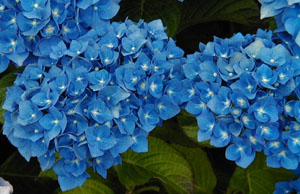I am not going to pretend to have absorbed enough wisdom and expertise to pass it all on to you. Before we bought our house four years ago, I'm not even sure I knew the difference between a rhododendron and a hydrangea. Growing up, my mom would say things like, "OHHH, LOOOOK at the RHODODENDRON!!! Aren't they GOOORGEOUS???" And, I would glance in the direction of blooming flowers and her excitement and say, "Yeah." But I didn't really know which flowers were the rhododendron, and I didn't really care. I started caring once we had a house and I began identifying the plants in our own yard, and those in other yards that I wanted to see in our yard. I can now proudly distinguish a hydrangea from a rhododendron, but an expert I am not.
Still, let me tell you the two main things I took away from the hour we spent with Mal learning about hydrangeas.
1. Don't be afraid to prune.
My mom has lots of beautiful established hydrangeas in her yard, but after making the mistake of pruning one year and having no flowers, we have both been hesitant to touch them. Mal, however, was very comfortable with his pruning shears. He said the best time to prune away the dead stems is in March, but that didn't stop him from cutting away lots and lots of them at the end of May. If it didn't have any leaf growth, it was dead, and he cut it out. Even if it did have some leaf growth, he cut down to the last flower node, removing the dead part from the top of the branch. This inspired me and my mom to do a little clean up on her shrubs when we got home.
Before:
After:
He said that the next time to prune is in July, just after they've flowered. That's when you want to shape the shrub, trimming for a uniform look at the top, and removing any branches that cross each other from the bottom.
Last year, I tried to make my own hydrangea, taking clippings from my mom's house. I'll do this again next month and post a step-by-step of the process. We did a total of twenty clippings and I have two and a half plants to show for it.

(I'm only counting this one as a half because it's much smaller than the others and I'm not sure it's going to make it.)
I am actually very happy with a little bit greater than 10% success rate, but I learned a few things that I'll do differently next time. For one, Mal said that he keeps propogated hydrangea in a pot for at least one winter before planting it, storing it in a garage or shed to shelter it from the wind. I didn't do that.
I also learned that an easier way to propogate is to bury one of the branches on an established shrub and let it turn into a new plant. I'll try that next month, too.
Lastly, while he was going crazy with his pruning shears, Mal knocked off some new growth from the top of a few plants and gave them to us. He said we could just stick them in dirt and mist them and in two weeks we'd have roots. So, here they are.

If they survive, someday they will look like this:
 |
| Hydrangea Lilacina |
 |
| Hydrangea Enziandom |





No comments:
Post a Comment